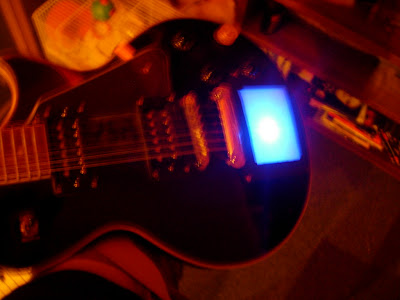Please bear in mind, these pictures were taken with the touch pad not there. All thats different is there should be a white ribbon, but its explained without anyway!
Firstly, there are 4 main exterior screws fixing the back panel onto the body. This seems the obvious place to start, however it probably makes more sense to begin with the step in the photo below (I just found it less awkward tipping it on its side to with the back cover ON where if it fell the circuit wasnt exposed to bits an pieces, but its a minor risk and up to you.) So just unscrew these 4 and lift the back panel off carefully by its rubber feet or let it drop upside down, then marvel Korg's glistenin ocean of silicone and solder. Pretty neat. Be careful from now on.

Bear in mind how annoying the ones in the middle of the RCA connectors are until you get the nack.
Now you're onto unscrewing the actual PCB. The first one is on the top, makes sense, and assuming you just completed removing the 5 screws on the back of the exterior, all you need now do is remove the 2 screws marked yellow. Once you've done this, DONT try to lift the PCB at any sort of angle. Theres loads of stuff really compacted and will clash and simply not come out UNLESS you just carefully slide it in (so the inputs etc come into the device) keeping it flat, it will not go any further than literally about exactly where it needs to be, then once its just there, lift it up keeping it horizontal. Once its loose (although remember it's still connected by plenty of ribbons and wires to the lower PCB and another small one) you can lift it over the other, and I just proped it up at an angle over the edge near the ribbon cables. 
Now you're looking at the lower PCB. To remove the touch pad, unscrew the 5 yellow circled screws on the pad. My ones kept falling around the PCB which probably isnt very good at all, so I remembered to grab them after a while.
Circled RED are the ribbon connectors terminals (the component is on opposite side of PCB). Normally, a thin green semi-transparent 4 way ribbon connector slips into the connector on the opposite side, so be careful when you move the PCB around because its pretty fragile, or seems it anyway.
This is a close up of the terminals. The colours don't, really show anything I'm not entirely sure why I put them on in different colours. Make sure you have a good knowledge of what was where, I just remembered how it all fit together and worked it out logically and visually, after writing it down caused some problems!

This is the PCB when I'd put it back together and added 4 wires to the holes which the connector terminals used to occupy. At this point, I just kept the connector attatched to the ribbon seperate, as this is where it will be eventually, with the DB9 Serial Port on. Likewise, these wires were put to use as seen below...

There, not very neat and tidy, and probably prone to snapping, but theres the basic electronics modification complete. For the PCB at least, the pad process is seperate (haven't got photos at present and I treat it as a seperate process in a way).




3 comments:
Post a Comment